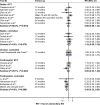The effect of domiciliary noninvasive ventilation on clinical outcomes in stable and recently hospitalized patients with COPD: a systematic review and meta-analysis
- PMID: 27698560
- PMCID: PMC5034919
- DOI: 10.2147/COPD.S104238
The effect of domiciliary noninvasive ventilation on clinical outcomes in stable and recently hospitalized patients with COPD: a systematic review and meta-analysis
Abstract
Introduction: Noninvasive ventilation (NIV) improves survival among patients with hypercapnic respiratory failure in hospital, but evidence for its use in domiciliary settings is limited. A patient's underlying risk of having an exacerbation may affect any potential benefit that can be gained from domiciliary NIV. This is the first comprehensive systematic review to stratify patients based on a proxy for exacerbation risk: patients in a stable state and those immediately post-exacerbation hospitalization.
Methods: A systematic review of nonrandomized and randomized controlled trials (RCTs) was undertaken in order to compare the relative effectiveness of different types of domiciliary NIV and usual care on hospital admissions, mortality, and health-related quality of life. Standard systematic review methods were used for identifying studies (until September 2014), quality appraisal, and synthesis. Data were presented in forest plots and pooled where appropriate using random-effects meta-analysis.
Results: Thirty-one studies were included. For stable patients, there was no evidence of a survival benefit from NIV (relative risk [RR] 0.88 [0.55, 1.43], I2=60.4%, n=7 RCTs), but there was a possible trend toward fewer hospitalizations (weighted mean difference -0.46 [-1.02, 0.09], I2=59.2%, n=5 RCTs) and improved health-related quality of life. For posthospital patients, survival benefit could not be demonstrated within the three RCTs (RR 0.89 [0.53, 1.49], I2=25.1%), although there was evidence of benefit from four non-RCTs (RR 0.45 [0.32, 0.65], I2=0%). Effects on hospitalizations were inconsistent. Post hoc analyses suggested that NIV-related improvements in hypercapnia were associated with reduced hospital admissions across both populations. Little data were available comparing different types of NIV.
Conclusion: The effectiveness of domiciliary NIV remains uncertain; however, some patients may benefit. Further research is required to identify these patients and to explore the relevance of improvements in hypercapnia in influencing clinical outcomes. Optimum time points for commencing domiciliary NIV and equipment settings need to be established.
Keywords: COPD; domiciliary; hospitalization; meta-analysis; noninvasive ventilation; systematic review.
Figures






References
-
- Vestbo J, Hurd SS, Agusti AG, et al. Global strategy for the diagnosis, management, and prevention of chronic obstructive pulmonary disease: GOLD executive summary. Am J Respir Crit Care Med. 2013;187(4):347–365. - PubMed
-
- Seemungal T, Donaldson G, Paul E, Bestall J, Jeffries D, Wedzicha J. Effect of exacerbation on quality of life in patients with chronic obstructive pulmonary disease. Am J Respir Crit Care Med. 1998;157(5 Pt 1):1418–1422. - PubMed
-
- Britton M. The burden of COPD in the U.K.: results from the Confronting COPD survey. Respir Med. 2003;97(Suppl C):S71–S79. - PubMed
-
- Connors AF, Jr, Dawson NV, Thomas C, et al. Outcomes following acute exacerbation of severe chronic obstructive lung disease. The SUPPORT investigators (Study to Understand Prognoses and Preferences for Outcomes and Risks of Treatments) Am J Respir Crit Care Med. 1996;154(4):959–967. - PubMed
Publication types
MeSH terms
Grants and funding
LinkOut - more resources
Full Text Sources
Other Literature Sources
Medical

